





Höga Kusten, the high coast - from a German perspective, this is true in every respect. It's not just that Sweden's island with the highest elevation is located here. The region is also geographically high up in the north, more precisely in the Bothnian Sea, a good 600 nautical miles away from German harbours. This is probably the only way to explain why the girlfriend suggests travelling to the holiday destination by motorhome as an exception.
Just a moment! Sweden. Archipelago. Lots of islands. In a motorhome? Objection! You must be able to hire a boat somewhere. You'd think so. But there are no charter bases on the coast north of Stockholm, far and wide. Unless, of course, you fancy the idea of hiring a private yacht. These are offered in Sweden on internet portals such as "Rtc Batkontakten" or "Skipperi". You can find all kinds of boats there. Most of them are not usually available from commercial charter companies: not professionally maintained, sometimes quite old or very small. An initial search reveals that the selection is meagre in the desired area of all places.
Somewhat adventurous but charming private charter
How can that be? A supposedly beautiful stretch of Swedish coastline, a World Heritage Site even, famous for its unspoilt nature, dense greenery, charming guest harbours - and then only one rental boat? Right in the middle of it all. In a place called Ullånger. An old Albin Accent. The charter price for the week is 400 euros for the small 26-foot yacht. Can't complain or do much wrong, can you? Without further ado, we contact the owner, a woman called Heidi, by e-mail.
The sailing boat is ready for use, she says. And if you like it, you can even buy it. Unfortunately, she couldn't hand it over herself as she was on holiday. But we learn everything we need to know in a follow-up email: "Hello, the boat is in Ullånger. I think, boatplace is number 13, name of boat acc 32." Some technical instructions follow. "When you come to the boat pull the thing in the box right opposite the toilet." Important. Otherwise the engine will stop, she writes. Aha! Pull the thing in the box opposite the toilet! That's the petrol tap. Private charter has its own rules.
Where there is water at Höga Kusten, it is also deep enough for sailing
The more information we receive, the more perplexed the girlfriend becomes. The cryptic boat name alone: "Acc 32". And the fact that the owner doesn't even know where her boat is moored. Does that seem like someone who loves and cares for their boat? The fact that Mrs Heidi offers to buy it straight away also makes you wonder.
I hold against it: No risk, no fun. And besides, we don't want to cross the Bay of Biscay with the boat. Theoretically, we can stay within the ten-metre depth contour. At Höga Kusten, this means that you can almost touch land when sailing with an outstretched arm. Or in other words: where there is water, it is deep enough to sail.
No sooner said than done, Ullånger arrives. Somewhere in the deepest Swedish province. The heart of the village is the petrol station on the thoroughfare. From here it's a ten-minute walk to the boat. Not a soul around the jetty. But the Albin is there. In a deep sleep. The key is next to the gas bottle. Fortunately, there's no mustiness below deck, but plenty of warm teak, no headroom (that was clear) and few dishes (that wasn't clear). There is a note on the saloon table. Written in Swedish. From the guests before us. A kind of list of shortcomings, as we learn via the translator app: The toilet doesn't work. And the carpet in the lounge is said to be wet sometimes.
The Albin Accent is an early design by Peter Norlin
"Well, that's great. This is exactly how I imagined it," sighs her friend. She thinks it's all a bit unkind, while I inspect the small boat at the most critical point: the bilge and keel bolt. Both look good. And dry. The engine also does what it's supposed to. There are nautical charts and life jackets. The sails still look passable. And this early design by designer Peter Norlin should sail well anyway. So what more could you want? The slightly annoyed reply from the girlfriend follows promptly: "A second coffee mug and a frying pan wouldn't be bad." And the fact that buckets and shore toilets have to replace the on-board toilet is not ideal either.
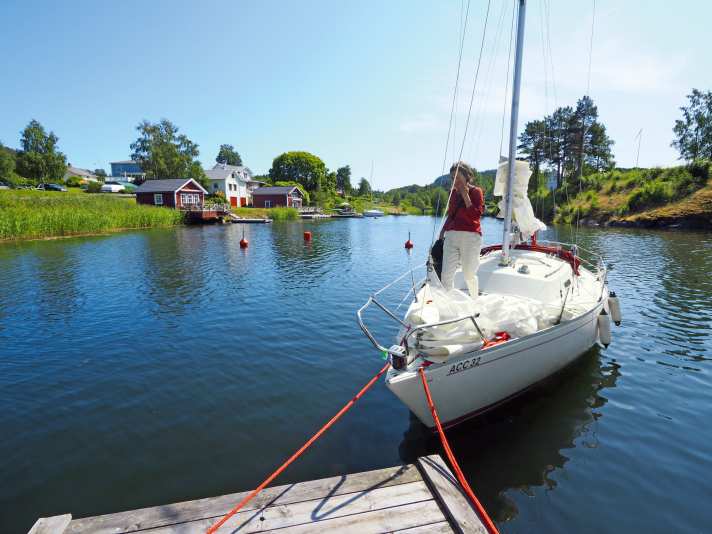
We cast off anyway. And experience the first surprise: there are hardly any other sailors around us. Despite the high season! We pick up speed. The bay becomes a fjord, the fjord widens and the first islands appear in front of it. As far as the waves and salt content of the water are concerned, everything feels like an inland cruise. What's more, you are never far from the coast and can keep comfortably to leeward of the islands. Ideal for small boats.
When there are few waves, she makes rapid progress. In gusts, the old Albin leans nobly to one side and behaves almost like a full-grown tall ship. No shooting into the wind, no hectic big fiddling. The rudder pressure remains manageable and the boat accelerates to over six knots. Which feels much faster this close to the water. In other words, the corners of your mouth go up for the first time. And, warning, spoiler: They stay there.
It doesn't get much more idyllic and Scandinavian than Höga Kusten
The first port of call is the island of Mjältön, Sweden's highest island at 236 metres above sea level. Baggviken is located on the eastern side. An almost circular natural harbour with jetties, barbecue areas and a sauna. You can hardly find a more idyllic, safe, Scandinavian harbour. We are late, drop the stern anchor and moor up next to another yacht near the sauna. Their crew has been working on the Midsummersail the longest and, according to the organisers, toughest Baltic Sea regatta from Wismar to the legendary northernmost buoy at Töre. There's a lot to tell. Not the only participating yacht that we will encounter over the next few days on their way back south-west, heading for home.
The next morning we head in the opposite direction. Our next destination is Trysunda. Further north. A good option with south-easterly winds between 3 and 4 Beaufort. We sail through an unspoilt, magnificent landscape that would hardly have looked any different thousands of years ago. Just a little flatter perhaps. The Höga Kusten is still growing.
The Höga Kusten is still growing. To this day, the region rises by eight millimetres every year.
During the last ice age, a three-kilometre-thick ice sheet covered the land. This was pressed down as a result of the enormous weight. When the ice melted, the land rose again, by up to 285 metres. To this day, the region rises by eight millimetres every year.
Trysunda has just two inhabitants and a perfect guest harbour
After a good two hours, the perfect idyll suddenly appears before us: the guest harbour of Trysunda. It's no wonder that the harbour is already well frequented by lunchtime. Saltkrokan sends its regards. The former fishing village is popular with Swedes and Finns alike. But a small boat like the Albin always finds a place. And that's not all: it is even welcome by the harbour operator. Especially as they pay a flat rate per boat. He explains: "As the boats are getting wider and wider, we lose a few places every year. We may soon have to charge according to width."
Shortly afterwards, we walk round the island. Trysunda is a nature-protected gem. With just two inhabitants who live here all year round. All the other houses are only used during the holidays. You might not want to spend the winter on the island, but the summer months - absolutely! The Dutch couple who run the harbour and the small café certainly make a very relaxed impression.
Ulvön is the home of Surströmming
The next day we set off for Ulvön, the tourist centre on the Höga Kusten. We have to sail the last few miles to thread our way into the narrow fairway. An entrance like somewhere in Canada. You'd only wonder about bears on the shore for a moment. Ulvön was once the largest fishing village in Norrland, which is why the island is also known as the "Pearl of the Bothnian Sea" or the "Sandhamn of Norrland". The historic boathouses, residential buildings and farms reveal how people once lived here.
You would only wonder about bears on the shore for a moment
Surströmming, the notorious stinky fish, also comes from Ulvön. A kind of assassination on the nose that the palate hardly dares to try. In spring, the herring is pickled in brine. Later packed in tins, the fermentation process continues so that the base and lid of the tins bulge menacingly. It is no coincidence that the transport of surströmming cans is expressly forbidden on some airline flights due to the risk of explosion. No joke!
The guest harbour is reserved for participants in a regatta, who gradually arrive to applause. But once again we find a place for our little one. We wait for the evening light and hike up the Lotsenberg. The view is magnificent.
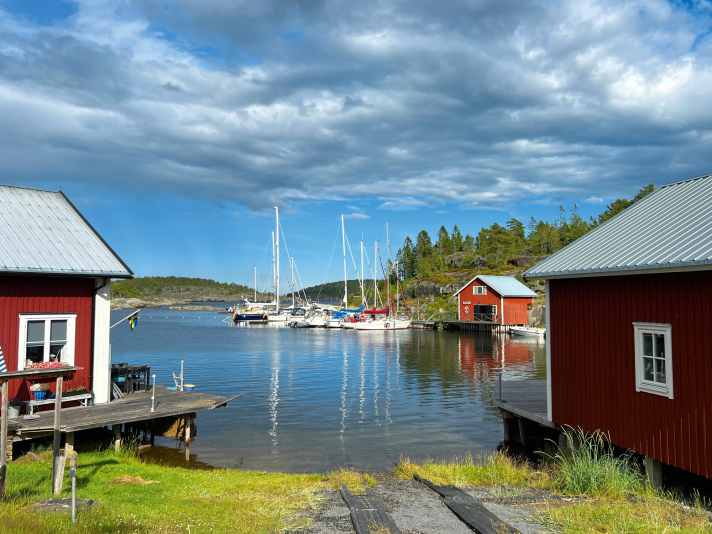
Worth seeing: the Fritidsbåtmuseet in Härnösand
New day, new destination. And a magical morning. Behind a breezy wall of fog that we sail through lies Bönhamn. Time seems to have stood still in this picturesque village. Red-painted boathouses huddle around the small harbour in a sheltered bay. Behind them are the old racks on which fishermen once dried their nets.
The southernmost point of our cruise is Härnösand. If only because there is the Fritidsbåtmuseet here, a museum that specialises in sport and leisure boats in Sweden and has collected over 40 unique watercraft. On display is the Swedes' love of the sea and the relationship between boat and owner.
With one boat per 13 inhabitants, Sweden is one of the countries with the highest density of pleasure craft in the world. On the one hand likeable, on the other hard to believe. At least not after spending a week in the high season with hardly any other yachts. But above all: the private charter experiment was a success. Thanks to a small boat and a magnificent natural spectacle.
Five tips for sailing along Höga Kusten
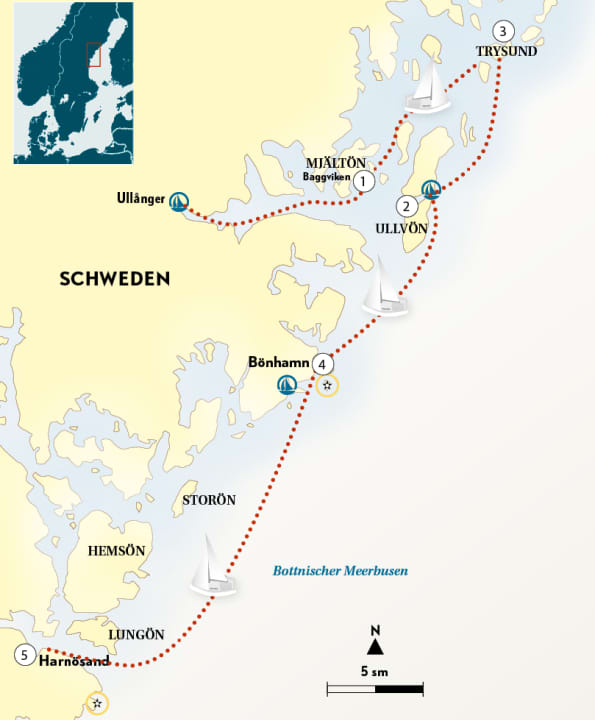
1. baggviken
This dream bay is located on Mjältön, the highest island in Sweden. A beautiful, sheltered spot for self-catering holidaymakers. No shops or restaurants. It could hardly be more Scandinavian. With a sauna on the shore, of course. If you want to get moving: the path to the summit is about two kilometres long and well worth it!
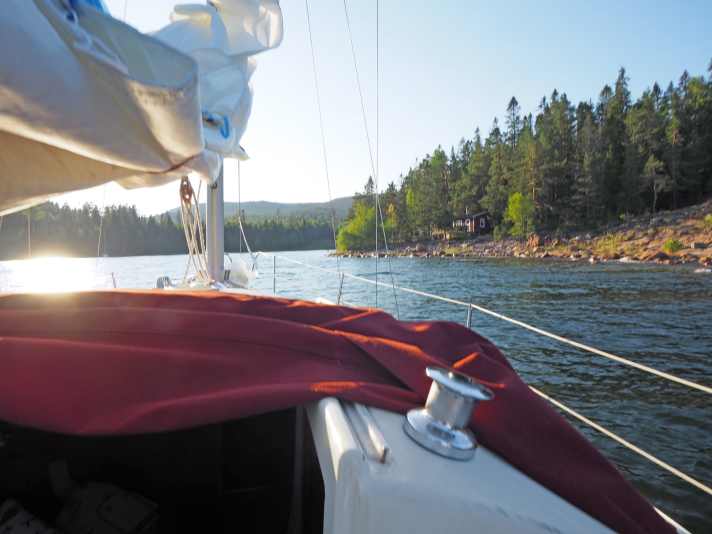
2. ulvön
It is called the pearl of the Bothnian Sea and is the main attraction of Höga Kusten. History buffs can learn about the development of fishing and surströmming at the island museum. If you don't fancy a tasting, visit the excellent bistro "Ruben". Be sure to hike up the Lotsenberg at sunset.
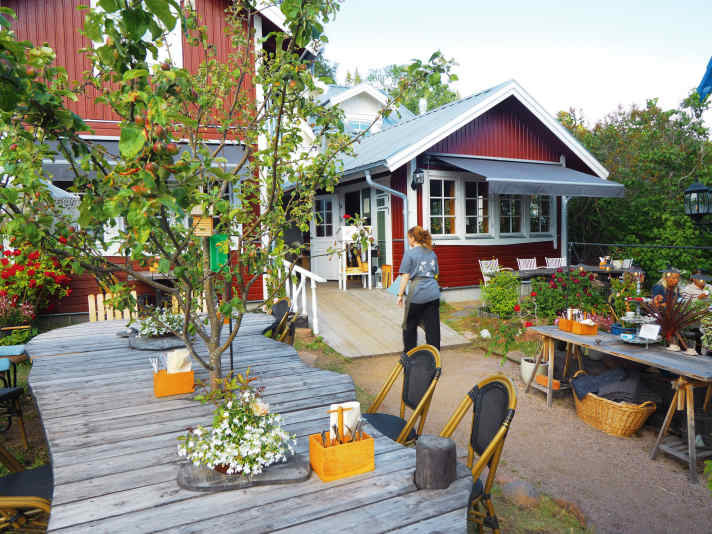
3. trysunda
The next highlight of the area. One of the most beautiful islands in Sweden. Forest, beach and archipelago transport the visitor into a walk-in picture book. The Skärgårdscaféet serves snacks. On sunny days, a detour to the fine sandy beach of Björnviken is recommended. An old locomotive from a former mine stands at the edge of the forest.
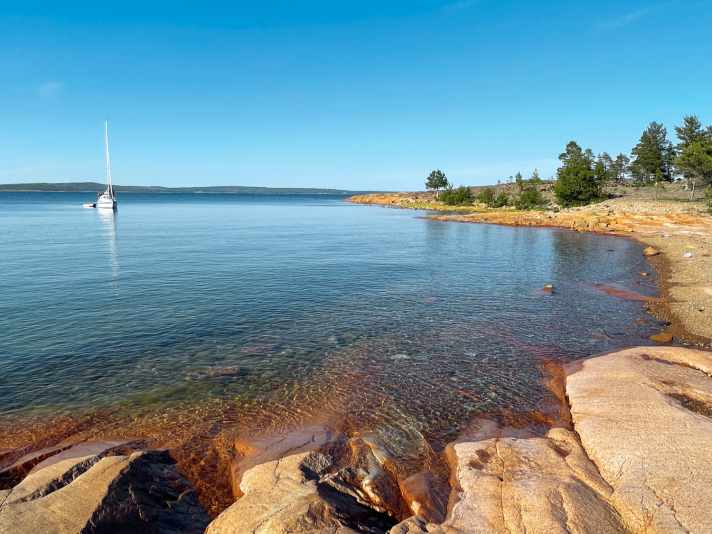
4th Bönhamn
Charming guest harbour in a beautiful location. A rewarding circular walk across the archipelago begins just behind the moorings. There is a restaurant and shopping facilities. If you want, you can take the ferry to the rocky island of Högbonden. Sweden's highest lighthouse is home to an original hotel.
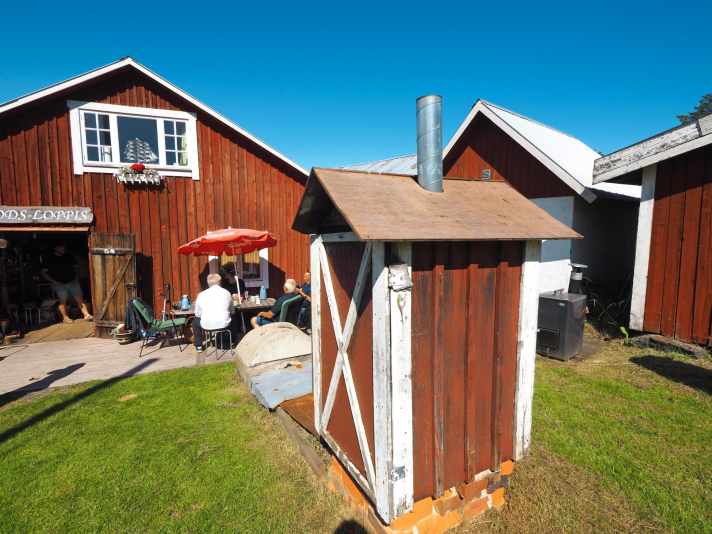
5 Härnösand
The historic harbour town is the gateway to the Höga coast. This is probably the best place to be if you need to weather. In addition to an art gallery and the technology museum, sailors should definitely take a look around the beautiful Fritidsbåtmuseet. The exhibition is a marvellous tribute to the Swedes' love of boating.
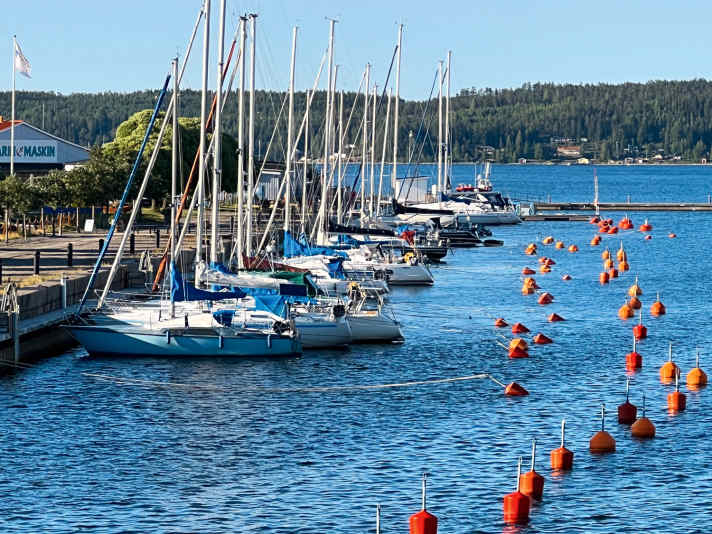
Area information Höga Kusten
Charter
We were travelling with an Albin Accent. The 26-foot boat costs 5250 kroner per week, or 450 euros. Large selection of boats throughout Sweden at skipperi.se or rtc.se Enter "Höga Kusten" in the search mask.
The precinct
The "High Coast" is a UNESCO World Heritage Site. The approximately 120 kilometre-long stretch of coastline is characterised by endless forests, wild river valleys and a sometimes dramatically steep coastline. Nevertheless, you often feel like you are on an inland waterway: good protection, short distances. The salinity of the water at Höga Kusten is close to zero. The tourist centres of the region are Härnösand in the south and Örnsköldsvik in the north.
Wind & Weather
Ideally, summer is characterised by a Scandinavian high. The winds then often blow moderately from southerly directions and it is usually warm and dry. However, fog is also to be expected in summer due to the cool water.
Navigation & Seamanship
The area poses few challenges for sailors. The water is often deep right up to the shore. We managed well without a plotter. Compared to the Stockholm archipelago, the Åland Islands or the Turku archipelago, there are few shallows, but plenty of charming, uncrowded marinas - albeit with limited supply options. A stern anchor is often required. Mooring prices are moderate at 10 to 20 euros.
Maps & Manuals
- "Coastal Handbook Baltic Sea" Delius Klasing Verlag, 69.90 euros.
- "Hamnguiden", vol. 10, Skagerrak Verlag, 74.90 euros.
- Sea chart: Swedish series "Bottenhavet N Norra", 78 euros, for example from Hansenautic

